Bukit Panjang LRT line
| Bukit Panjang LRT line Laluan LRT Bukit Panjang 武吉班让轻轨线 பக்கிட் பஞ்சாங் வரி | |||||||||||||||||||||||||||||||||||||||||||||||||||||||||||||||||||||||||||||||||||||||||||||||||||||||||||||||||||||||||||||||||||||||||||||||||||||||||||||||||||||||||||||||||||||||||||||||||||||||||||||||||||||||||||||||||||||
|---|---|---|---|---|---|---|---|---|---|---|---|---|---|---|---|---|---|---|---|---|---|---|---|---|---|---|---|---|---|---|---|---|---|---|---|---|---|---|---|---|---|---|---|---|---|---|---|---|---|---|---|---|---|---|---|---|---|---|---|---|---|---|---|---|---|---|---|---|---|---|---|---|---|---|---|---|---|---|---|---|---|---|---|---|---|---|---|---|---|---|---|---|---|---|---|---|---|---|---|---|---|---|---|---|---|---|---|---|---|---|---|---|---|---|---|---|---|---|---|---|---|---|---|---|---|---|---|---|---|---|---|---|---|---|---|---|---|---|---|---|---|---|---|---|---|---|---|---|---|---|---|---|---|---|---|---|---|---|---|---|---|---|---|---|---|---|---|---|---|---|---|---|---|---|---|---|---|---|---|---|---|---|---|---|---|---|---|---|---|---|---|---|---|---|---|---|---|---|---|---|---|---|---|---|---|---|---|---|---|---|---|---|---|---|---|---|---|---|---|---|---|---|---|---|---|---|---|---|---|
|
| |||||||||||||||||||||||||||||||||||||||||||||||||||||||||||||||||||||||||||||||||||||||||||||||||||||||||||||||||||||||||||||||||||||||||||||||||||||||||||||||||||||||||||||||||||||||||||||||||||||||||||||||||||||||||||||||||||||
|
| |||||||||||||||||||||||||||||||||||||||||||||||||||||||||||||||||||||||||||||||||||||||||||||||||||||||||||||||||||||||||||||||||||||||||||||||||||||||||||||||||||||||||||||||||||||||||||||||||||||||||||||||||||||||||||||||||||||
| Overview | |||||||||||||||||||||||||||||||||||||||||||||||||||||||||||||||||||||||||||||||||||||||||||||||||||||||||||||||||||||||||||||||||||||||||||||||||||||||||||||||||||||||||||||||||||||||||||||||||||||||||||||||||||||||||||||||||||||
| Type | Automated guideway transit/People mover | ||||||||||||||||||||||||||||||||||||||||||||||||||||||||||||||||||||||||||||||||||||||||||||||||||||||||||||||||||||||||||||||||||||||||||||||||||||||||||||||||||||||||||||||||||||||||||||||||||||||||||||||||||||||||||||||||||||
| System | Light Rail Transit (Singapore) | ||||||||||||||||||||||||||||||||||||||||||||||||||||||||||||||||||||||||||||||||||||||||||||||||||||||||||||||||||||||||||||||||||||||||||||||||||||||||||||||||||||||||||||||||||||||||||||||||||||||||||||||||||||||||||||||||||||
| Status | Operational | ||||||||||||||||||||||||||||||||||||||||||||||||||||||||||||||||||||||||||||||||||||||||||||||||||||||||||||||||||||||||||||||||||||||||||||||||||||||||||||||||||||||||||||||||||||||||||||||||||||||||||||||||||||||||||||||||||||
| Termini |
Choa Chu Kang Ten Mile Junction (to cease operations in Q4 2018) | ||||||||||||||||||||||||||||||||||||||||||||||||||||||||||||||||||||||||||||||||||||||||||||||||||||||||||||||||||||||||||||||||||||||||||||||||||||||||||||||||||||||||||||||||||||||||||||||||||||||||||||||||||||||||||||||||||||
| Stations | 14; 1 to cease operations in Q4 2018 | ||||||||||||||||||||||||||||||||||||||||||||||||||||||||||||||||||||||||||||||||||||||||||||||||||||||||||||||||||||||||||||||||||||||||||||||||||||||||||||||||||||||||||||||||||||||||||||||||||||||||||||||||||||||||||||||||||||
| Services | 3; 1 to cease operating in Q4 2018 | ||||||||||||||||||||||||||||||||||||||||||||||||||||||||||||||||||||||||||||||||||||||||||||||||||||||||||||||||||||||||||||||||||||||||||||||||||||||||||||||||||||||||||||||||||||||||||||||||||||||||||||||||||||||||||||||||||||
| Daily ridership | 62,700 | ||||||||||||||||||||||||||||||||||||||||||||||||||||||||||||||||||||||||||||||||||||||||||||||||||||||||||||||||||||||||||||||||||||||||||||||||||||||||||||||||||||||||||||||||||||||||||||||||||||||||||||||||||||||||||||||||||||
| Operation | |||||||||||||||||||||||||||||||||||||||||||||||||||||||||||||||||||||||||||||||||||||||||||||||||||||||||||||||||||||||||||||||||||||||||||||||||||||||||||||||||||||||||||||||||||||||||||||||||||||||||||||||||||||||||||||||||||||
| Opened | 6 November 1999 | ||||||||||||||||||||||||||||||||||||||||||||||||||||||||||||||||||||||||||||||||||||||||||||||||||||||||||||||||||||||||||||||||||||||||||||||||||||||||||||||||||||||||||||||||||||||||||||||||||||||||||||||||||||||||||||||||||||
| Owner | Land Transport Authority | ||||||||||||||||||||||||||||||||||||||||||||||||||||||||||||||||||||||||||||||||||||||||||||||||||||||||||||||||||||||||||||||||||||||||||||||||||||||||||||||||||||||||||||||||||||||||||||||||||||||||||||||||||||||||||||||||||||
| Operator(s) | SMRT Light Rail (SMRT Corporation) | ||||||||||||||||||||||||||||||||||||||||||||||||||||||||||||||||||||||||||||||||||||||||||||||||||||||||||||||||||||||||||||||||||||||||||||||||||||||||||||||||||||||||||||||||||||||||||||||||||||||||||||||||||||||||||||||||||||
| Character | Elevated | ||||||||||||||||||||||||||||||||||||||||||||||||||||||||||||||||||||||||||||||||||||||||||||||||||||||||||||||||||||||||||||||||||||||||||||||||||||||||||||||||||||||||||||||||||||||||||||||||||||||||||||||||||||||||||||||||||||
| Depot(s) | Ten Mile Junction | ||||||||||||||||||||||||||||||||||||||||||||||||||||||||||||||||||||||||||||||||||||||||||||||||||||||||||||||||||||||||||||||||||||||||||||||||||||||||||||||||||||||||||||||||||||||||||||||||||||||||||||||||||||||||||||||||||||
| Rolling stock |
Bombardier Innovia APM 100 C801 Bombardier Innovia APM 100 C801A Bombardier Innovia APM 300 C801B (future) | ||||||||||||||||||||||||||||||||||||||||||||||||||||||||||||||||||||||||||||||||||||||||||||||||||||||||||||||||||||||||||||||||||||||||||||||||||||||||||||||||||||||||||||||||||||||||||||||||||||||||||||||||||||||||||||||||||||
| Technical | |||||||||||||||||||||||||||||||||||||||||||||||||||||||||||||||||||||||||||||||||||||||||||||||||||||||||||||||||||||||||||||||||||||||||||||||||||||||||||||||||||||||||||||||||||||||||||||||||||||||||||||||||||||||||||||||||||||
| Line length | 7.8 km (4.8 mi) | ||||||||||||||||||||||||||||||||||||||||||||||||||||||||||||||||||||||||||||||||||||||||||||||||||||||||||||||||||||||||||||||||||||||||||||||||||||||||||||||||||||||||||||||||||||||||||||||||||||||||||||||||||||||||||||||||||||
| Electrification | 600V AC Third rail | ||||||||||||||||||||||||||||||||||||||||||||||||||||||||||||||||||||||||||||||||||||||||||||||||||||||||||||||||||||||||||||||||||||||||||||||||||||||||||||||||||||||||||||||||||||||||||||||||||||||||||||||||||||||||||||||||||||
| |||||||||||||||||||||||||||||||||||||||||||||||||||||||||||||||||||||||||||||||||||||||||||||||||||||||||||||||||||||||||||||||||||||||||||||||||||||||||||||||||||||||||||||||||||||||||||||||||||||||||||||||||||||||||||||||||||||
The Bukit Panjang LRT line is a 7.8-kilometre (4.8 mi) automated guideway transit line opened on 6 November 1999 as part of Singapore's LRT system. As an elevated people mover system, it is fully automated, and the project was contracted to Adtranz, Keppel Corporation and Gammon Construction. The line uses Innovia APM 100 rolling stock supplied by Adtranz (now Bombardier). A complete loop journey on the line (excluding Ten Mile Junction LRT station) takes 28 minutes. It is the first line of the LRT system in Singapore and like all other LRT lines, it is fully elevated and uses automated trains. It is the only LRT line to be operated by SMRT Light Rail.[1]
History
The idea of Bukit Panjang LRT was first pitched in 1991 before the government announced (in 1994) that it would pilot the system there. Two years later, in 1996, construction began for the Bukit Panjang LRT, which has the following features.
- It is driverless and fully automated.
- There are 14 stations.
- There is an integrated development at Ten Mile Junction LRT station, comprising a station, depot and shopping centre
The LRT is planned to run above ground to avoid the road safety issues of trams, and because it is obstructing the KTM tracks, according to Low Seow Chay. Recalling "terrible" traffic jams at the junction of Woodlands Road and Choa Chu Kang Road during the early 90s, he explained: "The Bukit Panjang residents had trouble accessing the Choa Chu Kang MRT station and bus interchange including towards the city due to the poor traffic flow." The KJE was opened in 1994, diverting most of the heavy traffic and solving the problem. He also asked for a dedicated bus viaduct to be built to relieve congestion, but the request was rejected as the LRT was the main option.
Back in 1994, Mr Mah Bow Tan, then the minister overseeing transport told Parliament of the need for “efficient and affordable” public transport, and that the potential of LRT as an internal feeder service was being studied. There are other intentions of the LRT to replace all the feeder buses. Today, residents have LRT and few feeder bus services.
Incidents
An LRT train with 20 passengers crashed into an empty one at Phoenix station on 19 November 2000 after an operations officer failed to do a manual check of the lines before restarting the network system. The impact threw seated and standing passengers to the floor of the train, injuring five of them. The service was disrupted for seven hours but it was restored in stages and was fully functional again by 2.30 pm the same day. Then Communications and Information Technology Minister Yeo Cheow Tong visited the site soon after being told of the accident. However, the cause of the accident was never uncovered till this day.[2]
On March 9, 2015, during the evening peak hours, the Bukit Panjang LRT was suspended from service for full 24 hours due to a power trip which was caused by a fire at Senja station. The fire was caused due to a sudden power surge and the fuse box failed to handle the surge. Usually the fuse box will trip the system and activate safety measures, but on that day the fuse box failed to do so and instead burst into flames. The problem was identified as arcing problem which was why the power "jumped". The reason for how the fire started, however, is still a mystery till today.[3]
On the late morning of 28 July 2016, a train departed Segar for Jelapang on Service B. However, the train sped past Jelapang, Senja and Bukit Panjang stations. One of the passengers said that the Emergency Stop Button was not working, and there was no response on the Emergency phone. According to a passenger, the train finally stopped before Phoenix station after another passenger managed to make a call on her mobile phone. Subsequent investigations showed that the train had a faulty antenna which resulted in the stations not being able to receive information about the train and thus did not stop the train at the stations.[4][5]
On the evening of September 27, 2016, a track fault resulted in the damage of the collector shoes on 15 train cars. This resulted in multiple delays and disruptions across the entire network and the damaged collector shoes further damaged the entire network's tracks. During the morning peak of the following day (September 28, 2016), the already damaged track resulted in further disruptions 4 hours after train service started. When the trains did arrive the stations, more problems occurred, including stalled trains, smoke, and stuck doors that staff had to open manually. With damaged tracks and half of the usual fleet running, the delays were more severe than previous cases this year (2016). Later in the afternoon, SMRT announced on social media, Facebook and Twitter, stating that only Service B is available and train service towards Choa Chu Kang station are unavailable. However, they announced again that train service has been temporarily suspended as engineers were carrying out maintenance and repair works. Train service fully resumes at 5:45pm with only half of the usual fleet operating.[6]
In the wee hours of 24 March 2017, a man was killed in a train accident after the last train left Fajar LRT station. Residents, however, reported nothing unusual around the time of incident, and the body was found when a staff went to the platform levels to do routine checks. Straits Times revealed that in the past there were 2 cases of accidents along the same line. In 2000, Mr See Chau Lai, a hawker assistant, died after he was hit by a train near Jelapang LRT station of the same LRT line. A coroner's inquiry found that he walked along the tracks after having too much to drink. That was the first fatality since the Bukit Panjang LRT started operations. In 2010, a LRT technician died of injuries sustained after being hit by a train at Phoenix LRT station. Mr Chia Teck Heng was checking the power rail between Phoenix and Bukit Panjang stations.[7]
On 28 March 2017, trains broke down on the line, leading to 65 people having to be evacuated. The Singapore Civil Defence Force arrived shortly after and guided the stranded passengers to the nearest station. SMRT later revealed that the incident was due to a propulsion fault on one of the train cars.[8]
On 9 September 2017, two trains successively stalled between Phoenix and Bukit Panjang stations, resulting in train services along the entire line becoming unavailable for six and a half hours. The first train was moved back to the depot whereas engineers had to evacuate stranded passengers from the second. The cause was found to be two broken rail support brackets that disrupted the ground and signal rails.[9][10]
Controversy
On 12 September 2017, speaking at an event commemorating the completion of a power-rail upgrading project for the NSEW MRT lines, Minister for Transport, Khaw Boon Wan suggested that the Bukit Panjang LRT was built as an "afterthought" due to "political pressure".[11] Mr Khaw said that the trains were designed in a "masochistic" manner, forcing commuters to go up and down with the twists and turns. He also compared the ride to a roller coaster, saying that it caused him dizziness.[12] His comment is taken to imply that his predecessor Mah Bow Tan erred in approving the LRT system. It also trivialises the work and contribution of railway engineers. Most critically, it implies that the PAP government had subcumbed to pressure and spent hundreds of millions of dollars without serious consideration and robust planning.[13]
Services
There are three services on the line: A and B terminate at Choa Chu Kang, and C ends at Ten Mile Junction. Service C is expected to cease operations when the Ten Mile Junction station ceases to operate.
| Service | Terminal | via | Notes |
| A | Choa Chu Kang | Senja | Senja to Petir Clockwise direction |
|---|---|---|---|
| B | Choa Chu Kang | Petir | Petir to Senja Anti-clockwise direction |
| C | Ten Mile Junction | Senja | Operates every 20 Minutes. Loops clockwise via Senja to Petir ; expected to cease operation after BP14 Ten Mile Junction's closure |
Stations
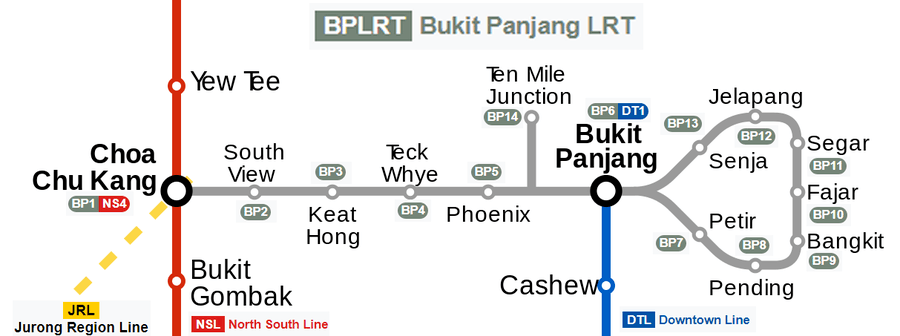
All stations, except Choa Chu Kang and Ten Mile Junction, have two facing side platforms. Choa Chu Kang has an island platform, similar to most Singapore MRT stations, while Ten Mile Junction has only a single platform and is the only station with platform screen doors (supplied by Horton Automatics). Bukit Panjang and Choa Chu Kang have half-height platform barriers. Choa Chu Kang station will have two additional platforms and a new set of fare gates to ease crowding during peak hours. Between 2016 and 2017, they will install Half-Height Platform Barriers to the remaining 11 LRT stations. This was completed in April 2017.
| Number | Name | Image | Interchange/notes |
| NS4 JS1 BP1 | Choa Chu Kang | 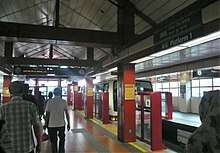 | Interchange with the North South line and the Jurong Region line (2026) Terminus for Services A & B |
| BP2 | South View |  | |
| BP3 | Keat Hong | ||
| BP4 | Teck Whye | ||
| BP5 | Phoenix | 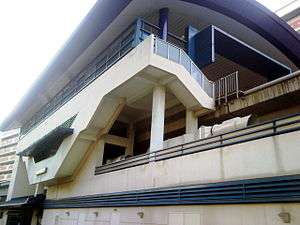 | |
| BP6 DT1 | Bukit Panjang |  | Connected to the Downtown line Service A & B bound for Choa Chu Kang Service C bound for Ten Mile Junction |
| BP7 | Petir |  | |
| BP8 | Pending |  | |
| BP9 | Bangkit | ||
| BP10 | Fajar | 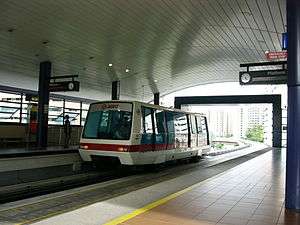 | |
| BP11 | Segar | ||
| BP12 | Jelapang | ||
| BP13 | Senja | 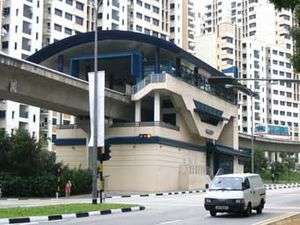 | |
| BP14 | Ten Mile Junction | Service C terminus |
Rolling stock
The line uses Bombardier Innovia APM 100 "people-movers", similar to the ones used by the Changi Airport Skytrain until 2006, coded C801 and C801A. C801s have been in operation ever since the start of service on the line in 1999, while C801As were delivered and started operations in late 2014. Each unit is 12,800 millimetres (41 ft 11.9 in) long.
Train formation
As of 2015, the majority of trains are in two-car (M-M) formations. Two-car formations are no longer limited to peak hours only and are now used at all times. This is due to the increase in ridership and the large number of apartments around Bukit Panjang. The units are limited to a two-car train formation because of station length.
Coupling is usually done in Ten Mile Junction Depot and the trains are coupled with the same car type: C801+C801 or C801A+C801A. Occasionally units are mixed for reasons such as rescue operations or testing.
Train control
The line is equipped with Bombardier’s CITYFLO 550 fixed block signalling system for Automatic train control (ATC) under Automatic train operation (ATO) GoA 4 (UTO).[14] The subsystems consist of Automatic train protection (ATP) to govern train speed, Automatic Train Supervision (ATS) to track and schedule trains, and a computer-based interlocking (CBI) system that prevents incorrect signal and track points settings.
Future plans
SMRT and LTA announced for plans to completely overhaul the BPLRT system as the system is reaching its lifespan of 20 years. A few reasons for the overhaul of the system was due to the fact that the system has been plagued with problems since its first operation in 1999 and it is one of the two systems in the world that still uses the CX-100 train cars (the other being Miami MetroMover).[15] On 8 March 2017, The Bukit Panjang LRT will be upgraded to a new conventional LRT system like power supply, signalling, rolling stock, track, stations, new signalling system and upgrading, including ruling out of the scrapping of the entire system or changing to an automated guided vehicles that is drawn on self-power, as it will cause major traffic congestion.[16]
On 3 October 2017, A tender for the revamp of the Bukit Panjang LRT was announced and was to be awarded in early 2018.[17]
On 16 October 2017, Transport Minister Khaw Boon Wan has announced plans to shut the Bukit Panjang LRT down for a small number of years to pave the way for the system's overhaul.[18] “If we want to do serious upgrading — essentially to close it down so that we can re-do the whole tracks and so on, so that we don’t have these ups and downs. And we’re evaluating that proposition,” he told reporters at a press briefing.[19]
On 23 October 2017, SMRT announced that the Bukit Panjang Light Rail Transit (BPLRT) system will begin operations at 7am, instead of 5.30am, on all Sundays from November 12 2017 until the end of the year, to allow more time for works to improve service reliability.[20] "With the later opening on Sundays, our maintenance teams will have 1.5 more hours on top of the existing 2 hours every night. This is crucial as it allows our engineers to undertake heavy maintenance works and expedites scheduled replacement works," SMRT said in a Facebook post on November 5, 2017.[21]
On 7 March 2018, the Land Transport Authority awarded the contract to Bombardier Transportation for $344 million on upgrading the system. This includes replacing the line's signalling system with the new Communications-Based Train Control system for a tighter headway between each trains and thus, reducing waiting time. 19 first-generation trains will be replaced while 13 second-generation trains will be refurbished.[22] The upgrade is slated to be completed by 2024. [23]
On 23 March 2018, SMRT said that the Bukit Panjang LRT Line will be closed on 11 Sundays from 15 April 2018 to 24 June 2018 as part of maintenance works aimed to improving the reliability of the beleaguered system.[24][25][26][27]
On 21 June 2018, SMRT said from 1 July 2018 to 28 October 2018, all BPLRT stations will open on Sundays at 8am, instead of the usual 5.30am.[28][29][30]
References
- ↑ "About SMRT: Business and Subsidiaries". Retrieved 4 November 2017.
- ↑ Foo, Author Joey (4 January 2012). "Bukit Panjang LRT: Vehicle collision of 19 November 2000". Retrieved 21 August 2016.
- ↑ "Bukit Panjang LRT services disrupted". TODAYOnline. Retrieved 21 August 2016.
- ↑ http://www.straitstimes.com/singapore/transport/antenna-fault-causes-bukit-panjang-lrt-train-to-skip-3-stations-smrt Antenna fault causes Bukit Panjang LRT train to skip 3 stations: SMRT
- ↑ http://www.channelnewsasia.com/news/singapore/fault-on-antenna-caused/3003026.html
- ↑ "From half service, to no service". The Straits Times. Retrieved 27 October 2016.
- ↑ "BPLRT Accident 2017". The Straits Times. Retrieved 24 March 2017.
- ↑ "Propulsion fault causes disruption". ChannelNewsAsia. Retrieved 28 March 2017.
- ↑ "Five-hour disruption on Bukit Panjang LRT line due to broken rail support brackets". Channel NewsAsia. 9 September 2017. Retrieved 9 September 2017.
- ↑ Lam, Lydia; Alkhatib, Shaffiq Idris (9 September 2017). "Broken rail support brackets behind 6-hour Bukit Panjang LRT disruption: SMRT". The Straits Times. Retrieved 9 September 2017.
- ↑ "Behind the 'political pressure' that led to the 'afterthought' of Bukit Panjang LRT". Channel Newsasia. 16 Sep 2017.
- ↑ Sean Chan Kit Whye (13 September 2017). "Transport Minister Khaw Boon Wan Admits Bukit Panjang LRT Was Built Under Political Pressure, Calls It An "Afterthought"". Must Share news.
- ↑ Don Ho Jia Hao (15 September 2017). "Hard to reconcile claim that Bukit Panjang LRT was an afterthought". Today.
- ↑ CITYFLO 550 - Singapore
- ↑ "SMRT reveals options to overhaul ageing Bukit Panjang LRT System". Retrieved 2017-03-08.
- ↑ "Bukit Panjang LRT to be Upgraded to a New Conventional and Reliable LRT line". The Straits Times. Retrieved 2017-03-08.
- ↑ "Tender to be called for Bukit Panjang LRT overhaul". October 3, 2017.
- ↑ "Govt may shut down Bukit Panjang LRT for at least 3 years: Khaw Boon Wan". The Independent. Retrieved October 19, 2017.
- ↑ "Govt mulling years-long shutdown to overhaul Bt Panjang LRT: Khaw Boon Wan". Today. Retrieved 2017-10-17.
- ↑ Cheng, Kenneth (23 October 2017). "BPLRT to start running later on Sundays from Nov 12 for renewal works". TODAY Online.
- ↑ "Bukit Panjang LRT to start at 7am every Sunday till year end". 11 November 2017.
- ↑ Land Transport Authority (7 March 2018). "Awarding of contract to renew BPLRT". Retrieved 10 March 2018.
- ↑ http://www.straitstimes.com/politics/parliament-344m-overhaul-of-bukit-panjang-lrt-smoother-rides-expected-from-2022
- ↑ http://www.straitstimes.com/singapore/transport/bukit-panjang-lrt-to-close-for-11-sundays-for-maintenance-works-starting-april
- ↑ https://www.channelnewsasia.com/news/singapore/bukit-panjang-lrt-reliability-renewal-signalling-system-lta-10070996
- ↑ https://sg.news.yahoo.com/bukit-panjang-lrt-close-sundays-15-april-24-june-maintenance-083105597.html
- ↑ https://www.todayonline.com/singapore/bplrt-be-closed-sundays-till-june-24-maintenance-work
- ↑ https://www.channelnewsasia.com/news/singapore/bukit-panjang-lrt-sundays-late-opening-10454556
- ↑ https://www.straitstimes.com/singapore/transport/bukit-panjang-lrt-to-resume-sunday-operations-in-july-but-with-later-opening
- ↑ https://www.todayonline.com/singapore/bukit-panjang-lrt-resume-operations-sunday-july-1-later-opening-time
External links
| Wikimedia Commons has media related to Bukit Panjang Light Rail Transit line. |
